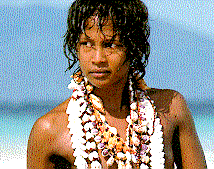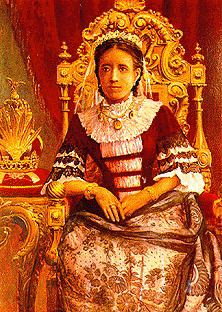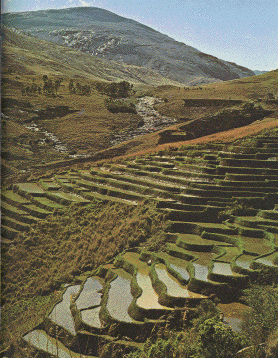|
Country
name: Republic of
Madagascar
Location: Indian ocean; S.E from African
Continent
Size: 594,180 sq km (231,730 sq mi)
Population: 14 million
Capital city: Antananarivo (Tana) (pop 750,000)
People: Mainly Malayo-Indonesian & mixed
African; also a large French; Indian; and Chinese
community
Language: Malagasy and French
Religion: Mainly Christian (official religion)
Government: Republic with President, Prime
minister and Parliament
 Environment Environment
The international conservation
community has singled out Madagascar as one of the
ecologically richest countries on the planet. With vastly
different habitats and a huge number of endemic (and some
very weird) species, Madagascar have nearly one-quarter
of all the flowering plants in Africa. It also has 90% of
the known species of lemurs, and half the world's
chameleons are found there; not to mention baobab trees,
orchids, unique cacti and aloes from the dry areas.
However, across the decades
population growth and the "slash-and-burn"
techniques used in some areas to grow rice have reduced
its originally vast rainforest to a remaining 15% (it is
said that Prince Charles shed a tear while flying over
the island), which is why Madagascar is also known as the
"red island". As a result, a great number of
endemic species are now endangered and vast protection
programs have been launched by the authorities in
cooperation with international conservation
organisations.
Climate:
Along the coast, climate is tropical (average
temperature: 24 to 26 degrees C)
In the highlands, it is temperate (average in
Antananarivo, at 1250 m : 18 °C)
In the south part of the island, it is arid, rain is
scarce
Seasons:
Southern summer (from November to
April) : warm and rainy season (alizés) In the period
between January and March, cyclones can occur ( East
coast and North mainly).
Southern winter (from April to October): dry season, with
cool temperatures, particularly on highlands. Temperature
can drop, at sunrise, till some degrees only (area
between Antsirabe and Fianarantsoa), in July and August
.
 People People
Little is known about the first
inhabitants of the Island. In Madagascar, there are many
legends about the "Vazimba" (pigmees) who
supposedly populated the island before the arrival of the
first immigrants. Although there are no clear proof ot
their existence, stone artefacts indicate an older
culture possibly existed there.
The current Malagasy people are a
mixture of Asians and Africans, and have been on
Madagascar for 1500 to 2000 years. Most of the immigrants
were Malay-Polynesians, who crossed the Indian Ocean from
Indonesia and South-East Asia, but people came from
eastern Africa as well. African slaves, Arab, Indian and
Portuguese traders, European pirates and French colonists
all mixed with the population to eventually create the 18
official `tribes' or clans inhabiting the island today.
List of the 18 official tribes of
Madagascar (in alphabetical order):
- Antaifasy
- Antaimoro
- Antaisaka
- Antakarana
- Antambahoaka
- Antandroy
- Antanosy
- Bara
- Betsileo
- Betsimisaraka
- Bezanozano
- Mahafaly
- Merina
- Sakalava
- Sihanaka
- Tanala
- Tsimihety
- Vezo
 History History
Beyond romantic stories about
european sailors and pirats - who actually set base in
the north and east of the island during the late 17th
century - Madagascar has a real history as a nation since
it existed as such long before many european or african
countries.
It's early history was marked by
successive immigrations from Asia, Africa and Europe and
the emergence of numerous regional kingdoms. Expansion
wars eventually led to its unification under one kingdom
in the late 18th century, ruled by a dinasty of Merina
kings and queens. The monarchy was brought down by the
french invasion in 1895. After a nationalistic
insurrection crushed in a bloodshed by the french in
1947, the Malagasy people eventually obtain back their
independance in 1960 with the advent of the Republic.
Key dates in the History of
Madagascar:
Until 18th:
Successive immigrations and emergence of small regional
kingdoms.
1787-1810:
Andrianampoinimerina becomes king of the Ambohimanga, one
of the Merina kingdoms. He starts expansion campaigns and
conquers half of the island.
1810-28: Radama I,
his son, succeeds to Andrianampoinimerina and completes
the unification of the island by conquering the rest of
the territory through war or alliance.
1818: Signature of
a treaty with Great Britain recognising Madagascar as an
independant state.
1828-61: Reign of
Ranavalona I, widow of Radama I. Known as a cruel queen,
she expelled all european missionaries out of the island
and persecuted christianty.
1861-63: Radama II
restores exchanges with Europe. He is assassinated after
2 years of reign.
1863-68:
Rasoherina his widow has to leave the real power to
Rainilaiarivony, the prime minister, which she marries,
in accordance with tradition.
1868-83:
Ranavalona II succeeds to Rasoherina and also marries
Rainilaiarivony who still controls the kingdom.
1883: Ranavalona
III (photo above) becomes queen. She will be the last
monarch to reign in Madagascar.
1895-96:
Malagasy-French war. The French army eventually defeats
the Merina defenses and invades the island (bloody
froggies)
1897: Ranavalona
III is sent in exile to Sainte Marie and later to
Algeria. Monarchy is abolished and Madagascar becomes a
French colony administered by general Gallieni.
1914-1918:
Thousands of Malagasy are enrolled in the French army and
fight World War I with the allies.
1940-42: The
French administration in the island is under the
authority of the Vichy collaborationist government.
1942-1945: The British defeat the french in
Madagascar and occupy the island, mainly to prevent the
Japanese from using it a base. They hand back the power
to general De Gaulle after the liberation of France.
1947: A
nationalistic insurrection is crushed by the French in a
bloodshed. Up to 80 000 malagasy reported killed (and
this was less than 3 years after they were liberated from
the nazis !).
1960: Madagascar
eventually obtains back its independance in a peaceful
transition.
1960-72: Philibert
Trisaranana is the first president of the new republic,
but he is under strong influence of Paris.
1972: Following
political unrest and a bloody repression of a revolt in
the south, Tsiranana is forced to hand power to his army
commander: general Gabriel Ramanantsoa. Ramanantsoa, more
nationalistic and favourable to socialist ideology will
start erasing all traces of french influence.
1975: Continuing
political instability forces Ramanantasoa to give up
power to colonel Richard Ratsimandrava, who is
assasinated only after a week in power. A directorate of
army officers declares martial law. Didier Ratsiraka, a
navy admiral and former foreign minister under
Ramanantsoa is appointed head of state. He was confirmed
president shortly after in a referendum. He will be
reelected in 1982 and 1989.
The regime led by Ratsiraka
launches a socialist revolution, severing ties with
western countries, turning to USSR and taking North Korea
as an model (and now the real trouble begins).
Mid 80s: Facing
economic disaster and pressure from IMF (International
Monetary Fund) , the regime starts a U-turn towards free
market economy and progressively restores exchanges with
western countries
1991: Social
unrest and general strike led by a movement called
"vital forces" forces Ratsiraka to accept
constitutional changes and early elections.
1992: Albert Zafy
a surgeon and leader of the opposition movement wins the
elections. The new constitution is voted and gives birth
to the 3rd republic.
1996: On the
charge of abuse of his constitutional power, Albert Zafy
is impeached by the parliament.
1997: New
elections are held and Didier Ratsiraka is voted back to
power (don't even try to understand!)
 Economic Profile Economic Profile
GDP: US$10.3 billion
GDP per head: US$790
Annual growth: 2.81%
Inflation: 35%
Major industries: Agriculture, textile, petroleum
products
Major trading partners: France, Italy, Japan, USA
  Culture Culture
One of the most remarkable aspect
of the Malagasy culture is the cult of ancestors. Its
most spetacular display is the tradition of
"famadihana" literarily "turning of the
bones", a family celebration during which the dead
are exhumed and reburied with gifts and new shrouds.
Although christian religion is widely spread, traditional
beliefs still holds an important place. Each one of the
various ethnical groups have its own "fomba"
(customs) and "fady" (taboos).
The roots of the Malagasy language
are basically Austronesian (Indonesian, Polynesian...),
mixed with african, arab, english and french words. Its
is a real language (not a dialect) in that it is widely
spoken throughout the country (although there are
variations according to the region) and has a structured
grammar. Malagasy litterature counts a number of locally
famous writers and poets.
The style of Malagasy music is as
diverse as its population, ranging from to dance rhythms
to melancholic love melodies, usually accompanied by
various types of guitars or flute. But the most typical
instrument than can only be found in Madagascar is the
Valiha, a tubular stringed instrument. There are also a
variety of craftwork with many typical objects.
A few outstanding concepts or
objects that characterise the Malagasy culture:
Razana: ancestors,
sacred in the malagasy culture.
Valiha: tubular
stringed instrument played more or less like a harp.
Antaimoro paper:
(backgound image of this page), decorated artesanal paper
made from a mixture
Aloalo: look like
indian totems, traditionally used in tombs, now widely
used in home decoration.
Vary: rice, which
is the base of all meals. The Malagasy eat rice 3 times a
day and are among the biggest (if not the biggest)
consumers per head in the world.
Romazava: main
specialty of Malagasy cuisine, basically beef and
vegetable stew accompanied with rice.
Kabary:
traditional oratory, an art of speech which follows very
specific rules
Moramora: litterarily
"smooth/easy". A sort of "no hurry"
attitude that have always been the doom of economic
development in the country.
|

 History
History